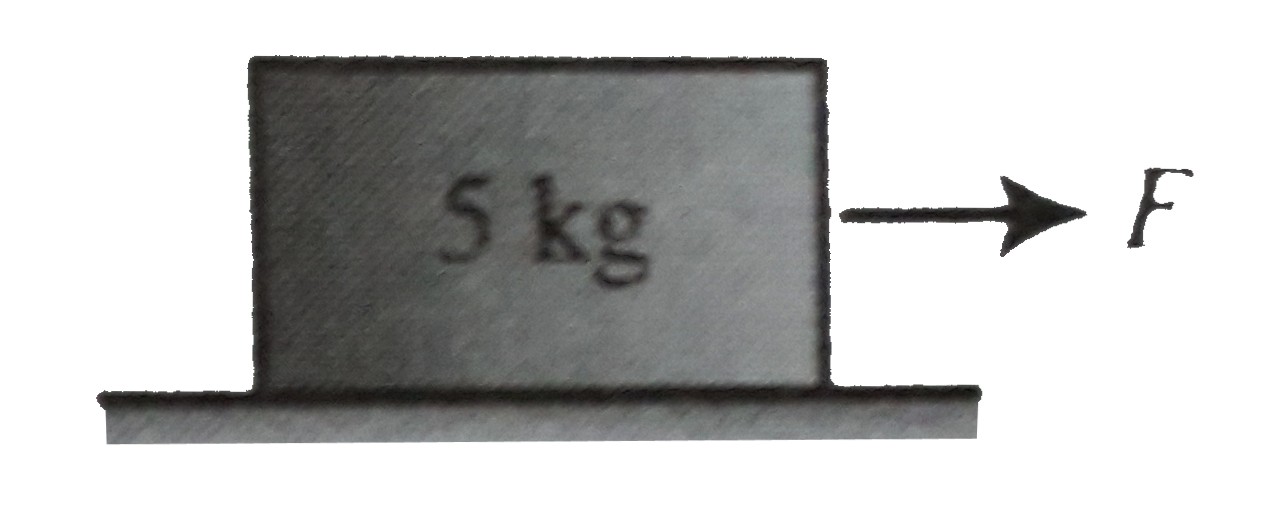A block of mass 100kg is kept on a horizontal rough surface. A man of mass 60kg is trying to pull the block with the help of ideal inextensible string. Find the minimum tension ( approximately ) in string to pull the block so that man remains at rest . Coefficient of friction between block and horizontal surface is 0.2 and that between man an horizontal surface is 0.5 ( g =10m/s2 )
100N
166N
180N
196N
The correct Answer is:D
To solve the problem, we need to find the minimum tension in the string that allows the man to pull the block without moving himself. We will consider the forces acting on both the man and the block.
Step 1: Calculate the maximum friction force acting on the man
The maximum friction force that can act on the man is given by:
Ffriction, man=μman⋅Nman
Where:
- μman=0.5 (coefficient of friction between the man and the surface)
- Nman=mman⋅g (normal force on the man)
Calculating Nman:
Nman=60kg⋅10m/s2=600N
Now, substituting this into the friction force equation:
Ffriction, man=0.5⋅600N=300N
Step 2: Calculate the maximum friction force acting on the block
The maximum friction force that can act on the block is given by:
Ffriction, block=μblock⋅Nblock
Where:
- μblock=0.2 (coefficient of friction between the block and the surface)
- Nblock=mblock⋅g (normal force on the block)
Calculating Nblock:
Nblock=100kg⋅10m/s2=1000N
Now, substituting this into the friction force equation:
Ffriction, block=0.2⋅1000N=200N
Step 3: Determine the minimum tension in the string
For the man to remain at rest, the tension T in the string must be equal to the maximum friction force acting on the man. Therefore, we have:
T=Ffriction, man
Since the block must also remain at rest, the tension must not exceed the maximum friction force acting on the block. Thus, we have:
T≤Ffriction, block
From our calculations:
- Maximum friction force on the man: 300N
- Maximum friction force on the block: 200N
The minimum tension required to pull the block while keeping the man at rest is determined by the limiting friction of the block:
T=200N
Conclusion
Thus, the minimum tension in the string required to pull the block so that the man remains at rest is approximately 200N.
The maximum friction force that can act on the man is given by:
Ffriction, man=μman⋅Nman
Where:
- μman=0.5 (coefficient of friction between the man and the surface)
- Nman=mman⋅g (normal force on the man)
Nman=60kg⋅10m/s2=600N
Ffriction, man=0.5⋅600N=300N
The maximum friction force that can act on the block is given by:
Ffriction, block=μblock⋅Nblock
Where:
- μblock=0.2 (coefficient of friction between the block and the surface)
- Nblock=mblock⋅g (normal force on the block)
Nblock=100kg⋅10m/s2=1000N
Ffriction, block=0.2⋅1000N=200N
For the man to remain at rest, the tension T in the string must be equal to the maximum friction force acting on the man. Therefore, we have:
T=Ffriction, man
T≤Ffriction, block
- Maximum friction force on the man: 300N
- Maximum friction force on the block: 200N
T=200N
Thus, the minimum tension in the string required to pull the block so that the man remains at rest is approximately 200N.
Similar Questions
A man pulls a block of mass equal to himself with a light string .The coefficient of friction between the man and the floor is greater than that between the block and the floor
View SolutionA block of mass m is placed at rest on a horizontal rough surface with angle of friction ϕ. The block is pulled with a force F at an angle θ with the horizontal. The minimum value of F required to move the block is
View SolutionA block of mass m is placed at rest on a horizontal rough surface with angle of friction ϕ. The block is pulled with a force F at an angle θ with the horizontal. The minimum value of F required to move the block is
View SolutionA block of mass 5kg rests on a rough horizontal surface. It is found that a force of 10N is required to make the block just move However , once the motion begains, a force of only 8N is enough to maintain the motion find the coefficient of kinetic and static friction between the block and the horizontal surface

View SolutionA block of mass 5kg rests on a rough horizontal surface. It is found that a force of 10N is required to make the block just move However , once the motion begains, a force of only 8N is enough to maintain the motion find the coefficient of kinetic and static friction between the block and the horizontal surface

View SolutionTwo blocks of masses 4kg and 6kg are kept on a rough horizontal surface as shown. If the acceleration of 6kg block is 5n, then n is :

View SolutionA block of mass 2 kg rests on a horizontal surface. If a horizontal force of 5 N is applied on the block, the frictional force on it is (take,uk=0.4,μs=0.5)
View SolutionA block is kept on a rough horizontal surface as shown. Its mass is 2 kg and coefficient of friction between block and surface (μ)=0.5. A horizontal force F is acting on the block. When

View SolutionA block of mass 10 kg is placed on the rough horizontal surface. A pulling force F is acting on the block which makes an angle θ above the horizontal. If coefficient of friction between block and surface is 43 then minimum value of force required to just move the block is (g=10ms2)
View SolutionA body of mass 20kg is moving on a rough horizontal plane. A block of mass 3kg is connected to the 20 kg mass by a string of negligible mass through a smooth pulley as shown in the figure. The tension in the string is 27 N. The coefficient of kinetic friction between the heavier mass and the surface is (g = 10m/s2)

View Solution
